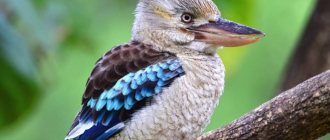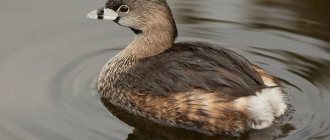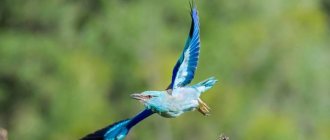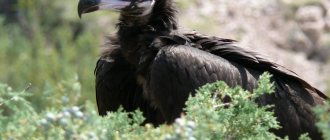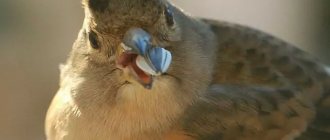The bittern is a bird of the heron family that lives on all continents except Antarctica. Few people manage to see these swamp inhabitants in their natural habitat, because the birds have unique camouflage abilities. But the main distinguishing feature of the bittern, which made it famous, is the loud, terrifying cry that the bird makes at night.
Great bittern - inhabitant of the swamps of Eurasia
Description of the bittern and origin of the name
The bittern is a large bird of the pelican order. The closest relatives of birds are herons, tops, night herons.
The Latin name for the bittern is Botaurinae, and the bird got its Russian name from the words “howl”, “howl”, because representatives of this family make very loud sounds. The cries of birds resemble the roar of a bull, which is why in Belarus the bittern is called the word “bugai”, which is also translated from the Belarusian language as “bull”.
In Bulgaria, the birds were given the name voden bik (water bull), but in Russia the bittern is often called the marsh bull.
Bittern or swamp bull with open beak
Bittern - an invisible inhabitant of the swamps
The bittern's ability to camouflage itself in its habitat is so developed that a person may not be aware of its existence until he hears the bird's voice, low and booming, similar to a bull's cry.
In the old days, this was the name of the secret inhabitant of the reed thickets - water bull or booze.
Appearance of bittern
The size of these heron representatives varies greatly depending on the type of bittern - in nature there is a large or true bittern and a small or little bittern. Here's some data:
- the average body length of a real bittern reaches 65–75 cm, a small one - 30–40 cm;
- the length of the wings of the great bittern reaches 43 cm, the top - up to 20 cm;
- wingspan - 100–115 cm and 45–55 cm, respectively;
- The average weight of an adult large bittern is 500–1100 g, and that of a small bittern is only 100–150 g.
INTERESTING FACT. The smallest member of the family is the black-backed bittern. The height of these birds reaches only 35 cm, the length of the wings is up to 15 cm, and the body weight is only 60–120 g. The largest species is the great European bittern: the body length reaches 85 cm, the wingspan is up to 120 cm, the weight is up to 1900 G.
The black-backed bittern is the smallest member of the family
The body of all bittern species is quite large and egg-shaped. The head of these birds is also large, and it is located on a powerful neck. The bittern has one peculiarity: the bird can adjust the length of its neck - stretch it out or, on the contrary, pick it up and press it to the body, depending on the external situation.
The bittern's head ends with a long, straight and sharp beak with small notches at the end. The beak is light yellow or gray, dotted with dark specks.
Very close to the base of the bird's beak are two large, round eyes. This arrangement allows the bittern to see well at dusk. Eye color is yellow or amber brown.
The birds' legs are short (when compared with other representatives of herons), but very thick. The leg ends with four long toes: three pointing forward, one pointing back. This arrangement helps the bird to move deftly not only on a flat surface, but also to walk through marshy swamps. Paws are gray-green.
The bittern's wings are wide and have a rounded shape at the ends. The bird's tail is short, as if sharply cut off.
Although the swamp bull boasts thick plumage, the color of the bird is not the most noticeable. The predominant color of the bittern is ocher-red, and dark streaks are scattered throughout the body. The top of the head of these birds is black, and the throat is most often light. There are dark longitudinal stripes on the belly of the bird (in some species they are absent or located on the back).
Individuals of the little bittern with an outstretched and retracted neck
Male and female bitterns: main differences
Female and male individuals of the true bittern differ in size: the male is 2–5 cm taller, and the difference in weight can even reach 500 g.
Only individuals of the genus Volochok differ in color. For example, in the little bittern:
- the wings, back and “cap” on the male’s head are black with a greenish tint, the plumage of the head and neck is beige or light gray;
- The female's back is dark brown with streaks, her head and neck are light brown, and her belly has dark longitudinal stripes.
Also, the male bittern has a yellow-green beak, while the female bittern has a predominantly yellow beak, with only a brown spot at the tip.
Similarities and differences between female and male bitterns
Description
The color is sandy-reddish, the entire plumage is dotted with numerous small dark streaks, which form longitudinal stripes on the underside of the neck. The legs are green, the beak is yellowish, the eyes are light brown or yellow. In flight, it is noticeable that the flight feathers are dark rufous with wide black stripes. Young birds are similar in color to adults, only duller. Before the appearance of feathers, the chicks are covered with thick reddish down.
The voice is peculiar: in spring and early summer, males indicate their presence in the thickets with a low, booming two-syllable hoot: “u-nummb.” In calm weather, this sound carries for several kilometers. It can be heard most often at night, but birds often cry during the day. A displaying male makes this sound by strongly inflating his neck. In flight, especially at night, it often emits a hoarse “how”, reminiscent of some of the calls of a gray heron.
Singing bittern
The cry of the bittern is one of the most remarkable features of this bird, which makes you avoid swamps.
The birds begin their eerie song in spring and summer, but the bittern screams loudest during the mating season - from April to May. In spring, the voice of this bird can be heard within a radius of even 2–4 km. The bittern howls mainly 2 hours before sunrise and 2 hours after sunset, but during the nesting period the screams are heard around the clock.
At the beginning of singing, the great bittern seems to sigh, bay, and then utter a loud, mooing “yip-yp...trumbbb.” The source of this sound, much like the roar of wind in pipes, is not the bird’s vocal cords, but the esophagus, which inflates and acts as a resonator. Because of the characteristic sound, the bittern received another nickname - booze.
The voice of the little bittern is more melodic: the top emits chirping “cro” and “vroo”, which resemble the caw of a crow. The bird repeats these sounds approximately every 2–3 seconds.
INTERESTING FACT. In the old days, the Slavs believed that mermaids and mermen made eerie sounds in the swamps. And even after learning that it was the voice of a bittern, people called the bird a symbol of evil spirits and believed that the cry of a bird was a harbinger of trouble.
We invite you to watch a short video and listen to the cry of the marsh bittern.
Types of bitterns
Two types of bitterns (greater and lesser) include 12 species of birds:
- Great European bittern (Botaurus stellaris);
- American bittern (Botaurus lentiginosus);
- South American bittern (Botaurus pinnatus);
- Australian great bittern (Botaurus poiciloptilus);
- little bittern (Ixobrychus minutus);
- Amur top (Ixobrychus eurhythmus);
- American bittern (Ixobrychus exilis);
- Chinese top (Ixobrychus sinensis);
- ocher little bittern (Ixobrychus cinnamomeus);
- gray-backed top (Ixobrychus sturmii);
- spotted top (Ixobrychus involucris);
- black-backed bittern (Ixobrychus dubius).
Let's look at the most common members of the family.
American bittern. It lives in Canada and the USA, winters in Central America and the Caribbean. Individuals of this species are of medium size: body length is 60–70 cm, weight - from 400 to 1000 g. The color is no different from most other members of the family: the back and wings are buffy-red with dark streaks and stripes, the belly is creamy white or yellow -brown.
American Great Bittern - inhabitant of the USA and Canada
Australian bittern (great). Distributed in Australia, New Zealand and the Pacific islands of Uvea and New Caledonia. The body length of birds of this species is 65–75 cm. Almost the entire body is dark, ocher-chestnut color, only at the base of the beak there is a yellow-green stripe.
Australian Great Bittern - native to Australia and New Zealand
Amur bittern. This species inhabits eastern China, Japan, northern Korea, and the southeastern part of Siberia. The birds are small - their body length reaches only 33–40 cm. The plumage of these tops is slightly different from the plumage of other members of the family: the belly of the birds is light ocher, the back of the female is red-brown, and the back of the male is chestnut.
The Amur bittern is a representative of China, Japan, Korea and Siberia
American bittern (also called Indian bittern). The birds breed in western North America, but are also found in the Brazilian state of Bahia, as well as in the Mexican state of Sonora. A distinctive feature of these birds is the purple-chestnut or greenish-black coloring of the head and back (the first in the female, the second in the male). The rest of the plumage is predominantly yellow-brown.
The American bittern is a colorful inhabitant of North America, Mexico and Brazil.
Gray-backed bittern. Distributed in all sub-Saharan African countries. The main distinguishing feature of this top is the dark gray plumage of the back, head, wings and tail. The belly is light cream, but also with gray longitudinal stripes.
Gray-backed bittern - a resident of Africa
The Chinese bittern lives exclusively in the Asian region (eastern, southeastern and southern parts of Asia). The bird is small, height is 30–40 cm. The plumage on the head is predominantly dark chestnut, only the crown is black. The main color of the back, wings, tail and belly is yellowish-buff, but there are white longitudinal stripes throughout the body.
Chinese bittern - a representative of Asia
Speckled top. Inhabitant of the South American continent (Venezuela, Paraguay, Argentina, Chile, Brazil and other countries). This is one of the smallest representatives of the family: the body length of the bittern reaches only 30 cm, weight - 150 g. The main color of the plumage is light ocher, white longitudinal stripes run along the belly, and black along the back. There is also a resin stripe on the top of the head.
Spotted top - an inhabitant of South America
In addition to the listed species, the New Zealand little bittern (Ixobrychus novaezelandiae) lived in New Zealand until the end of the 19th century. This is an extinct species.
Bittern range and habitat
Representatives of this heron subfamily nest on all continents except Antarctica. The greatest species diversity is found in Eurasia, and the widest range is found in the great and little bitterns.
The great bittern nests in Eurasia:
- from Portugal in the west to Sakhalin and Japan in the east:
- from the southern part of the Scandinavian Peninsula to Iran, Afghanistan and Korea.
This species is found even in southern Africa (South Africa, Mozambique, Zimbabwe).
Some areas of distribution of the great bittern on the map
Lesser bitterns live throughout Europe south of the Scandinavian countries, Central Asia, western India, and throughout sub-Saharan Africa and Australia.
There are 5 species of these birds represented on the territory of Russia:
- the small bittern lives throughout the European part south of St. Petersburg, in the Asian part - in the temperate zone to Western Siberia;
- the great European bittern is found throughout the territory south of St. Petersburg; bittern is found in Yakutia and Sakhalin;
- ocher top - single individuals nest in the south of Primorye;
- the Chinese bittern lives in the southern Kuril Islands and Sakhalin;
- The Amur top lives in southeastern Siberia.
Bitterns in Belarus (great and small) can be found almost everywhere, but the most individuals are represented in Polesie.
The buffy top is an inhabitant of Russian Primorye
Habitats
The bittern prefers to nest near bodies of water with stagnant water - swamps, lakes, reservoirs, fish ponds. Sometimes small slow-flowing rivers and even old peat mines become the bird’s habitat. The main factor in choosing a place to live is the presence of dense vegetation: there should be a lot of cattails, reeds, and reeds on the banks of reservoirs, so that in case of danger the bittern can hide. The open water areas required for hunting may be small.
The marsh bull prefers to avoid humans, but isolated individuals of the bittern were also encountered on overgrown city ponds.
Little bittern in the swamp
Migratory or wintering bird
The bittern is a migratory and wintering bird. Species that live in subtropical and tropical climates live in one place all year round. Migratory are:
- the American great bittern, which migrates from Canada and much of the United States to Central America, the Caribbean, and the southern United States for the winter;
- the small bittern from the countries of Western, Central and Eastern Europe prefers to fly to the north of Africa - to the Nile Valley;
- the Amur bittern winters in the countries of Southeast Asia (Thailand, Philippines, Indonesia) and in southern China;
- The great European bittern flies from temperate latitudes for the winter to the Mediterranean countries, Africa, the Caucasus and the southern part of Asia.
From the cold regions of Russia, birds often migrate to the Black Sea and Azov coasts.
The migratory period of the marsh bull is quite extended: the departure of the bittern begins in June and can last until November, but most birds leave their usual habitat in September. Birds return from wintering in March–May.
Some European bitterns prefer to remain in their homes for the winter, and when the swamps freeze due to severe frosts, the birds are left without food and die.
Great European bittern in flight
Natural enemies
The most significant harm to the great bittern population is caused by the unauthorized, massive destruction of all natural habitats of the bird. Conducting massive drainage reclamation by humans has become the main reason for the significant reduction in the number of this bird throughout Europe.
No less damage is caused by the fall of vegetation in the spring, which kills a significant part of the plants suitable for nesting of the great bittern. Scientists also suggest that very young bitterns may well be destroyed by many fairly large birds of prey, including the owl and eagle owl.
Return to content
Behavior and lifestyle
The water bull prefers a solitary lifestyle and never lives in a flock; even for the winter the birds fly alone.
The bittern is a nocturnal bird. At dusk, she walks through the swamp and looks for food. During the daytime, these birds prefer to stand motionless on one leg in the water, merging with the reeds. The marsh bull also makes migratory flights at night.
The bird does not really like to fly: it is easier for these birds to walk on their powerful legs, or even move from one reed to another. The bittern's flight is most often short-lived, straight, with occasional wing flaps.
What does bittern eat?
The bittern is a predator, and these birds eat exclusively animal food. The main diet of the water bull consists of:
- frogs;
- lizards;
- snakes;
- fish (pike, crucian carp, perch);
- crustaceans;
- rodents (water rats).
The favorite delicacy of these birds is eels. But if the bird cannot get large food, the bittern does not refuse tadpoles, newts, worms, insects and their larvae. Sometimes eggs and chicks of other birds fall into the beak of the water bull, and less often - small adult birds.
Photo of a little bittern eating a fish
The bittern hunts in an unusual way: at first it walks slowly through the swamp, peering into the mud, and when it notices its prey, it immediately freezes. It stands motionless for several seconds, and then makes a sharp lunge (sometimes the bird’s head is completely immersed in the water). Having grabbed the fish, the bull swallows it whole. Often during a hunt, bitterns can be seen deftly climbing plant stems.
We invite you to watch a short video of a small bittern hunting.
Eating in the wild
Nutrition is determined by the types of small animals and insects that live in a particular habitat. Usually these are eels, freshwater crustaceans, dragonflies, frogs, toads, as well as fish. There are always small fish in the middle zone of the continent. The diet of the great bittern consists of perch, crucian carp, tench, and small pike. In addition, the menu includes newts, tadpoles, worms, any aquatic insects that can be grabbed by the beak, and even small mammals.
On the hunt
Populations and species status
Despite the wide range of these birds, the birds are not very numerous - in most countries of Eurasia there are only a few individuals of bitterns. For example, in Europe there are only up to 12,000 pairs, in Russia - up to 30,000 pairs, in Turkey - only up to 500 pairs.
Today there is one endangered species of bittern in the world - the Australian great one. The number of individuals of this aquatic bull has decreased significantly due to the drainage of the swamps of Australia and New Zealand.
INTERESTING FACT. The Great Swamp Bittern is listed in the Red Books of Belarus, Moscow, Moscow and Kirov regions, the Komi Republic and Bashkortostan. This bird has also been protected in the UK for 40 years.
The decline in the numbers of all species of this subfamily occurs mainly due to people, or more precisely, due to the destruction of the bittern's habitat as a result of human activity. Main reasons:
- deterioration of the ecology of water bodies;
- burning cattails in the spring;
- development of swamps for agricultural land (reclamation).
Bitterns also die in traps that people set to catch muskrats. Birds also fall into the clutches of predators.
Grass fell in the swamps - the cause of bittern death
Natural enemies in the wild
Although the bittern is a large bird, it has enemies in its natural environment. The hunt for the swamp bull is carried out by:
- eagle owls;
- tawny owls;
- peregrine falcons;
- harrier hawk
Raccoons, weasels, minks, and snakes destroy bittern nests and eat their eggs.
Saving birds from enemies is clever camouflage. Due to the color of its plumage, bitterns are very difficult to spot in the reeds. And sensing danger, the bird freezes motionless and stretches its neck high, thanks to which it becomes even more like a marsh plant. The water bull even sways from side to side like a reed in the wind.
The bittern does not lose sight even when a predator approaches: it crouches to the ground, ruffles its feathers, spreads its wings and makes loud, rumbling sounds. Then it opens its beak wide and spits out recently eaten food at the enemy. If this does not help, the bird makes sharp lunges towards the enemy and tries to peck him right in the eye.
The bird flies away only in the most extreme cases. The flight of a frightened bittern is not very graceful: the bird wags in different directions, flaps its wings at random, and behaves hectic. Zoologist Heptner compared such a flight to “a rag dangling stupidly over the reeds.”
Photo of a little bittern camouflaging in the grass
How long does a bittern live?
The lifespan of these birds depends on the type of bird and the region where it lives. The average age of a bittern in the wild is 13–15 years, but, for example, the maximum recorded lifespan of the little bittern in Europe was only 8 years.
WHERE DOES IT LIVE?
The bittern lives in Europe and Central Asia. Its place of residence is high and dense reed thickets. This bird leads a secretive lifestyle. Quite often, a bittern lives very close to a person on a lake or swamp, where people come, but no one even suspects the existence of such a neighbor. Having settled in the reeds that grow in shallow water around lakes and along swampy river banks, the bittern finds here a sufficient amount of food and easily hides from enemies.
In winter, the reed dries out, and its stems and leaves settle to the bottom of the reservoir. Extremely fertile soil is formed from plant sediments, so European and Asian farmers in many places cut down reed thickets and drain the soil. These areas are then repurposed as agricultural land. Such actions lead to a decrease in the number of animals living in reed beds. In Great Britain, bitterns disappeared at the end of the 19th century. Individual birds began to appear again in England and build nests here only in 1911. The future fate of the bittern depends on whether people can preserve its places of residence.
How does the bittern reproduce and what kind of offspring does it produce?
The mating season for the water bull begins immediately after returning from wintering. Already in mid-March, the male tightens his loud “whoop-boom”, which attracts the female. If during the breeding season a male meets a rival on his territory, a fight breaks out between them. They ruffle their feathers and take turns attacking each other. The battle most often ends with the flight of one of the individuals, but sometimes the opponent dies.
The bittern is a polygamous bird: in addition to the fact that every year these birds look for a new mate, in one mating season a male can have several partners at once. The bittern father is also not the most respectable - after mating, the male takes almost no part in raising the offspring. Even the female builds the nest alone.
In the swamps, the bittern establishes a roost on hummocks hidden among the cattails. If the body of water is deep (for example, a lake), the marsh bull may nest on islands. The nest is built from thin stems of cattails and reeds.
The perch of these birds is not very neat, round in shape, with a recess of about 25–40 cm. The diameter of the nest, depending on the type of bird, is about 0.5–1 m.
Female little bittern on the nest
The female bittern usually lays from 3 to 6 eggs (the maximum recorded number is 9) about 5 cm long. The color of the eggs is gray or olive green.
Only the female incubates the eggs; the incubation period lasts from 21 days. The chicks hatch non-synchronously, but at intervals of approximately 2–3 days. Often the last baby born does not survive.
Newborns hatch with reddish-colored fluff. The chicks are fed by the female, in the first days the young feed on tadpoles, and gradually small fish are included in the diet.
2 weeks after birth, the chicks begin to leave the nest and look after nearby territories, and by the age of 1 month, the young can already fly. The bittern molts from August to January, and birds reach sexual maturity by 1 year.
The bittern lays only one clutch per year.
Bittern chicks in the nest
Interesting facts about bitterns
Here is some more interesting information about the water bull.
- Bittern chicks can sing from birth. But they do not make terrible sounds, but melodic gurgling sounds. The song of each adult bittern has its own characteristic, individual characteristics that allow scientists to distinguish birds from each other.
- The water bull became one of the heroes of the Brothers Grimm fairy tale “The Bittern and the Hoopoe.” The authors in their work also tried to explain the origin of the bittern's cry: this heron was herding cows among the green meadows, and due to the abundance of food, the horned animals became wild and did not obey the “shepherd.” The bittern tried many times to drive them away by shouting: “Let’s go!”, but nothing worked. The bird is still screaming.
- In Conan Doyle's story The Hound of the Baskervilles, the sounds frightening the heroes coming from the swamp were the cries of a large bittern.
- Since the 18th century, people have been hunting bitterns for the meat of these birds, but due to a significant reduction in individuals and their conservation status, today catching water bull is prohibited.
- The bittern is not adapted to life at home; it will never become tame. Even in zoos and nurseries, these birds are dangerous and often try to peck someone in the eye.
